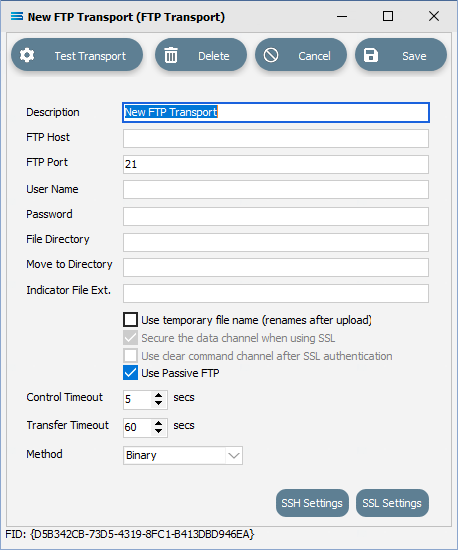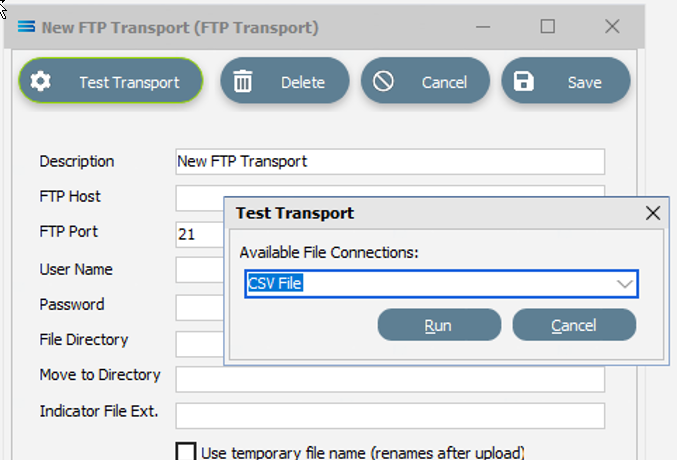FTP or FTP/S or SFTP (outbound)
A FTP Transport is used to connect to a FTP service over the internet or local network.
To enable files to be sent to the remote FTP service, you configure the FTP Transport with the appropriate details for connecting to the remote server and for sending files.
The FTP Transport can be used to make FTP, FTP/S, and SFTP connections. While SFTP has no relation to the FTP protocol technically, it is often confused with FTP, and for simplicity sake we have combined the two protocols.

Fields
Field Name | Description |
|---|---|
Description | A friendly name for the FTP Transport. This is the name that this Outbound Transport will be known as throughout the configuration. You should enter something meaningful to help you easily recognise the Transport. |
FTP Host | The domain name or IP address of the remote FTP server or service. |
FTP Port | The port that the remote FTP service is listening on. A default value will automatically display. |
User Name | A user name to access and connect to the remote FTP server or service. |
Password | A password for the above user. This will not be displayed on screen. |
File Directory | The directory on the FTP server to upload the file to. Enter the path relative to the root of the FTP service. |
Move to Directory | The directory on the remote FTP service to move the file to after uploading. Enter the path relative to the root of the FTP service. Some parties use this as a method of indicating that the file has finished uploading. |
Indicator File Ext. | If a value is entered, Statelake will create an indicator file with the same name as the uploaded file, but using the entered extension. Some parties use this as a method of indicating that the file has finished uploading. |
Use temporary file name (renames after upload) | A temporary file name to use during the file upload. The file will be renamed after the upload to the original name. Some parties use this as a method of indicating that the file has finished uploading. |
Secure the data channel when using SSL | This option is only available if SSL Settings are saved against this Transport. |
Use clear command channel after SSL authentication | This option is only available if SSL Settings are saved against this Transport. |
Use Passive FTP | Uses passive FTP connection mode. This is recommended. Untick to use active connections. |
Control Timeout | Time out period on the FTP control channel, in seconds. |
Transfer Timeout | Time out period on the FTP data channel, in seconds. A zero (0) means to wait forever. |
Method | Select either ASCII or BINARY mode for sending data. The default is BINARY which should be attempted as the first choice. |
Buttons
Button Name | Description |
|---|---|
Save | Click to Save any changes you have made. All changes will be lost if you do not click the Save button. |
Cancel | Click to Cancel any changes you have made. |
Delete | Click to Delete this particular Transport. You will be asked to confirm your choice. |
Test Transport | Click to test the connection to the remote FTP service. This is a live test. You need to select the File Connection that will be used to to find a file for sending. This will cause the transport to run and send the first file that exists in the File Connection that matches the File Search Pattern. |
SSH Settings | Click to edit the SSH settings used when making the connection to the FTP Transport. Select this button for SFTP. For information regarding this button, please refer to SSH Settings. |
SSL Settings | Click to edit the SSL settings used when making the connection to the FTP Transport. Click this button for TLS. For information regarding this button, please refer to SSL Settings (Email Settings). |
Test Transport
Once all details have been entered as required, click on this button to test the connection to the remote FTP server or service.
You need to select the File Connection that will be used to filter the files, and to provide detail of the directories to be used to receive any files into.
Test Transport is a live test and will cause the transport to run and send to the FTP server, the first file that exists in the File Connection that matches the File Search Pattern.
A pop-up Test Transport window will appear - select the appropriate File Connection from the drop-down list.

Click Run to perform the test, and Cancel to quit without testing.